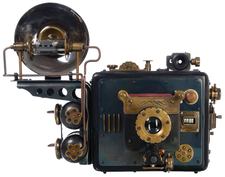Advertising with the Raspberry Pi
Show Talent

© Lead Image © 3355m, 123RF.com
Video sequences or slide shows promote sales. With a Raspberry Pi and the Raspberry Slideshow distribution, you can capture the attention you need.
Thanks to its active community and incremental improvements, the Raspberry Pi has long since surpassed the point of purely experimental applications. In the meantime, the miniature PC has made itself useful in the commercial environment, for example as a controller for industrial machines.
For this article, the Raspberry Pi comes into play where previously expensive TV sets with VCRs or, in recent times, individual computers with displays have been used for advertising purposes. With Raspberry Slideshow [1] and the tiny computer, you can bring multimedia content to the screen professionally and at a very low price.
Thanks to intelligent software, the Rasp Pi can easily supplement advertising columns and billboards. You can use the Raspbian-derivative Raspberry Slideshow to play a digital photo album or fade in video sequences, which can be mixed if necessary.
[...]
Buy this article as PDF
(incl. VAT)
Buy Linux Magazine
Subscribe to our Linux Newsletters
Find Linux and Open Source Jobs
Subscribe to our ADMIN Newsletters
Support Our Work
Linux Magazine content is made possible with support from readers like you. Please consider contributing when you’ve found an article to be beneficial.

News
-
Linux Mint 22.3 Now Available with New Tools
Linux Mint 22.3 has been released with a pair of new tools for system admins and some pretty cool new features.
-
New Linux Malware Targets Cloud-Based Linux Installations
VoidLink, a new Linux malware, should be of real concern because of its stealth and customization.
-
Say Goodbye to Middle-Mouse Paste
Both Gnome and Firefox have proposed getting rid of a long-time favorite Linux feature.
-
Manjaro 26.0 Primary Desktop Environments Default to Wayland
If you want to stick with X.Org, you'll be limited to the desktop environments you can choose.
-
Mozilla Plans to AI-ify Firefox
With a new CEO in control, Mozilla is doubling down on a strategy of trust, all the while leaning into AI.
-
Gnome Says No to AI-Generated Extensions
If you're a developer wanting to create a new Gnome extension, you'd best set aside that AI code generator, because the extension team will have none of that.
-
Parrot OS Switches to KDE Plasma Desktop
Yet another distro is making the move to the KDE Plasma desktop.
-
TUXEDO Announces Gemini 17
TUXEDO Computers has released the fourth generation of its Gemini laptop with plenty of updates.
-
Two New Distros Adopt Enlightenment
MX Moksha and AV Linux 25 join ranks with Bodhi Linux and embrace the Enlightenment desktop.
-
Solus Linux 4.8 Removes Python 2
Solus Linux 4.8 has been released with the latest Linux kernel, updated desktops, and a key removal.

